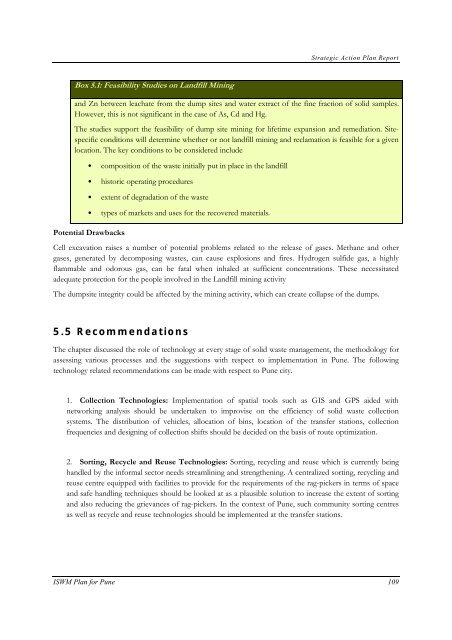Strategic Action Plan - International Environmental Technology Centre
Strategic Action Plan - International Environmental Technology Centre
Strategic Action Plan - International Environmental Technology Centre
You also want an ePaper? Increase the reach of your titles
YUMPU automatically turns print PDFs into web optimized ePapers that Google loves.
<strong>Strategic</strong> <strong>Action</strong> <strong>Plan</strong> Report<br />
Box 5.1: Feasibility Studies on Landfill Mining<br />
and Zn between leachate from the dump sites and water extract of the fine fraction of solid samples.<br />
However, this is not significant in the case of As, Cd and Hg.<br />
The studies support the feasibility of dump site mining for lifetime expansion and remediation. Sitespecific<br />
conditions will determine whether or not landfill mining and reclamation is feasible for a given<br />
location. The key conditions to be considered include<br />
• composition of the waste initially put in place in the landfill<br />
• historic operating procedures<br />
• extent of degradation of the waste<br />
• types of markets and uses for the recovered materials.<br />
Potential Drawbacks<br />
Cell excavation raises a number of potential problems related to the release of gases. Methane and other<br />
gases, generated by decomposing wastes, can cause explosions and fires. Hydrogen sulfide gas, a highly<br />
flammable and odorous gas, can be fatal when inhaled at sufficient concentrations. These necessitated<br />
adequate protection for the people involved in the Landfill mining activity<br />
The dumpsite integrity could be affected by the mining activity, which can create collapse of the dumps.<br />
5.5 Recommendations<br />
The chapter discussed the role of technology at every stage of solid waste management, the methodology for<br />
assessing various processes and the suggestions with respect to implementation in Pune. The following<br />
technology related recommendations can be made with respect to Pune city.<br />
1. Collection Technologies: Implementation of spatial tools such as GIS and GPS aided with<br />
networking analysis should be undertaken to improvise on the efficiency of solid waste collection<br />
systems. The distribution of vehicles, allocation of bins, location of the transfer stations, collection<br />
frequencies and designing of collection shifts should be decided on the basis of route optimization.<br />
2. Sorting, Recycle and Reuse Technologies: Sorting, recycling and reuse which is currently being<br />
handled by the informal sector needs streamlining and strengthening. A centralized sorting, recycling and<br />
reuse centre equipped with facilities to provide for the requirements of the rag-pickers in terms of space<br />
and safe handling techniques should be looked at as a plausible solution to increase the extent of sorting<br />
and also reducing the grievances of rag-pickers. In the context of Pune, such community sorting centres<br />
as well as recycle and reuse technologies should be implemented at the transfer stations.<br />
ISWM <strong>Plan</strong> for Pune 109
















